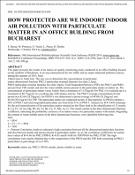Options
How protected are we indoor? Indoor air pollution with particulate matter in an office building from Bucharest
Date issued
2014
Abstract
This paper presents the results of an indoor air quality monitoring study conducted in an office building located
on the outskirts of Bucharest, in an area characterized by low traffic and no major industrial pollution sources,
during the summer of 2013, from 14thof June to 3rdof July. The aim was to determine the concentration of particulate matter dimensional fractions PM2.5 (particulate nominal diameter less than 2.5μm), PM10 (particulate nominal diameter less than 10μm), Total Suspended Particles (TSP), the PM2.5 and PM10
percent from TSP, metals and also the watersoluble anions present in the particulate matter in indoor air. The
concentration of particulate matter varies widely from a minimum of 11.93μg/m3 for PM2.5 in weekend up to a
maximum of 86.75μg/m3 in a working day with intense activity. The PM2.5 average concentration for the
period was 42.64±28.28μg/m3; for PM10 it was determined a period average of 44.09±28.29μg/m3 and
46.44±30.41μg/m3 for TSP. The particulate matter are composed mostly of fine particles; fo PM10 contains a
96% of PM2.5 and total suspended particulates are form from 91% of PM2.5. Analysis by ICPEOS technique
for the acid mineralization of the particulate matter retained on the filters lead to the identification of 15 metals:
K, Ca, Fe, Al, Na, Mg, Pb, Zn, Ni, Ba, Cu, Ti, Mn, As, Cr. The metal content in the three dimensional fractions
is different, indicating the probability existence of an indoor source for particulate matter with metals. Regarding
the content of watersoluble anion in the three dimensional fractions, were identified following ions:
NO3
> SO4
2>Cl >F >PO4
3>NO2. Pearson Correlation Analysis indicated a high correlation between all the dimensional particulate fractions
and also between metals and anions present in particulate matter. As so, the correlation coefficients for metals
have values of R=0.96 for PM2.5/PM10; R=0.93 and R=0.88 for TSP/PM10 for PM2.5/TSP. The high
correlations were maybe obtained due to the composition of the PM10 and the TSP, both consisting in PM2.5
particulates in percentage of over 90%.
on the outskirts of Bucharest, in an area characterized by low traffic and no major industrial pollution sources,
during the summer of 2013, from 14thof June to 3rdof July. The aim was to determine the concentration of particulate matter dimensional fractions PM2.5 (particulate nominal diameter less than 2.5μm), PM10 (particulate nominal diameter less than 10μm), Total Suspended Particles (TSP), the PM2.5 and PM10
percent from TSP, metals and also the watersoluble anions present in the particulate matter in indoor air. The
concentration of particulate matter varies widely from a minimum of 11.93μg/m3 for PM2.5 in weekend up to a
maximum of 86.75μg/m3 in a working day with intense activity. The PM2.5 average concentration for the
period was 42.64±28.28μg/m3; for PM10 it was determined a period average of 44.09±28.29μg/m3 and
46.44±30.41μg/m3 for TSP. The particulate matter are composed mostly of fine particles; fo PM10 contains a
96% of PM2.5 and total suspended particulates are form from 91% of PM2.5. Analysis by ICPEOS technique
for the acid mineralization of the particulate matter retained on the filters lead to the identification of 15 metals:
K, Ca, Fe, Al, Na, Mg, Pb, Zn, Ni, Ba, Cu, Ti, Mn, As, Cr. The metal content in the three dimensional fractions
is different, indicating the probability existence of an indoor source for particulate matter with metals. Regarding
the content of watersoluble anion in the three dimensional fractions, were identified following ions:
NO3
> SO4
2>Cl >F >PO4
3>NO2. Pearson Correlation Analysis indicated a high correlation between all the dimensional particulate fractions
and also between metals and anions present in particulate matter. As so, the correlation coefficients for metals
have values of R=0.96 for PM2.5/PM10; R=0.93 and R=0.88 for TSP/PM10 for PM2.5/TSP. The high
correlations were maybe obtained due to the composition of the PM10 and the TSP, both consisting in PM2.5
particulates in percentage of over 90%.
Files
Loading...
Name
SGEM 2014 BUCUR HOW PROTECTED ARE WE INDOOR_ INDOOR AIR [].pdf
Size
168.71 KB
Format
Adobe PDF
Checksum
(MD5):9f373657dad5037371ced56593d095e8